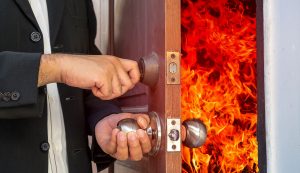Signs It’s Time to Replace Your Fire Doors
Fire doors are a crucial component of a building’s passive fire protection system. Designed to contain fire and smoke within specific areas for a predetermined amount of time, they protect lives, minimise property damage, and provide vital escape time for occupants. However, like any safety equipment, fire doors can deteriorate over time, compromising their effectiveness. Identifying when to replace your fire doors is essential for maintaining the safety and compliance of your building. Below, we outline the key signs that indicate it’s time to take action.
1. Visible Damage to the Door or Frame
One of the most obvious signs that a fire door needs replacing is visible physical damage. Cracks, dents, warping, or holes in the door or its frame can compromise its integrity. Damage may occur due to wear and tear, impact, or environmental factors like humidity. Even seemingly minor damage can affect the door’s ability to resist fire and smoke, so it’s critical to address these issues promptly.
2. Difficulty Closing or Latching
A fire door must be able to close fully and securely to function effectively. If a door sticks, drags, or fails to latch properly, it may not provide the necessary seal in the event of a fire. This issue could be due to misalignment, wear on hinges, or damage to the door’s hardware. If adjustments or repairs don’t resolve the problem, replacement is likely necessary.
3. Gaps Around the Door
Gaps between the door and the frame should be consistent and within approved tolerances (typically 3mm to 4mm). Excessive or uneven gaps can allow smoke and flames to pass through, undermining the door’s purpose. If your fire door has significant gaps that cannot be corrected by adjusting the hinges or frame, it’s time to consider a replacement.
4. Damaged or Missing Intumescent Strips
Intumescent strips are essential components of fire doors, designed to expand when exposed to high temperatures to seal gaps and prevent the spread of fire and smoke. Over time, these strips can become worn, damaged, or dislodged. If inspection reveals missing or compromised intumescent strips, replacing the door may be the safest option to ensure compliance and effectiveness.
5. Warping or Distortion
Fire doors must remain flat and stable to perform correctly. Warping or distortion, often caused by exposure to moisture or extreme temperatures, can prevent the door from fitting tightly within its frame. A warped fire door cannot provide the necessary barrier against fire and smoke and should be replaced without delay.
6. Outdated or Non-Compliant Design
Building regulations and fire safety standards evolve over time. If your fire doors are outdated or no longer meet current requirements, they should be replaced with models that comply with the latest standards. Non-compliance can result in fines, legal issues, and increased risk to occupants.
7. Frequent Repairs
If a fire door requires constant maintenance or repairs, it may be more cost-effective to replace it altogether. Recurring issues often indicate underlying structural problems that repairs cannot fully resolve. Investing in a new fire door ensures reliability and long-term performance.
8. Missing or Damaged Certification Label
Certified fire doors must have a clearly visible label indicating their compliance with safety standards. If the label is missing, damaged, or illegible, there is no way to verify the door’s fire rating. In such cases, replacement is recommended to ensure the door meets the necessary specifications.
9. Damage to Glazing or Glass Panels
Fire doors with glass panels must use fire-resistant glazing to maintain their integrity. Cracks, chips, or breaks in the glass compromise the door’s ability to contain fire and smoke. Replacing the door is often the best solution to restore safety and compliance.
10. Age of the Fire Door
While fire doors are built to last, they have a finite lifespan. Over time, materials can degrade, and components like hinges and seals may wear out. If your fire door is over 10-15 years old, consider having it inspected by a professional. Even if it appears to be in good condition, advancements in fire safety technology may make replacement worthwhile.
Why Regular Inspections Are Crucial
Regular fire door inspections are essential for identifying the above signs and maintaining compliance with fire safety regulations. In the UK, the Regulatory Reform (Fire Safety) Order 2005 requires building owners and managers to ensure that fire doors are in good working order. Periodic inspections help to:
- Identify damage or wear before it becomes a safety hazard.
- Ensure all components, including intumescent strips and hardware, are functional.
- Verify that the fire door meets current safety standards.
Scheduling professional inspections at least every six months is recommended, with more frequent checks in high-traffic areas.
The Risks of Ignoring Fire Door Issues
Failing to replace a damaged or non-compliant fire door can have serious consequences, including:
- Increased Fire Spread: A compromised fire door cannot effectively contain fire and smoke, putting lives and property at greater risk.
- Regulatory Penalties: Non-compliance with fire safety regulations can result in significant fines or legal action.
- Insurance Complications: Many insurers require proof of compliance with fire safety standards. Faulty fire doors could void your policy in the event of a claim.
How to Replace Your Fire Doors
When it’s time to replace a fire door, working with a professional fire protection specialist is essential. The process typically involves:
- Assessment: Inspecting the existing door and determining the appropriate replacement.
- Selection: Choosing a fire door with the correct fire rating, size, and features for your needs.
- Installation: Ensuring the new door is fitted in compliance with relevant safety standards.
- Certification: Verify and document the fire door’s compliance for regulatory purposes.
Trust Original Fire for Your Fire Door Needs
At Original Fire, we specialise in fire door installation and maintenance, ensuring your building remains safe, compliant, and secure. Our team of experts is dedicated to providing high-quality solutions tailored to your unique requirements. If you’ve noticed any of the signs above or simply want to ensure your fire doors are performing as they should, contact us today for a professional assessment and advice.
Maintaining effective fire doors is not just about compliance—it’s about protecting lives. Don’t wait until it’s too late; act now to safeguard your building and its occupants.



